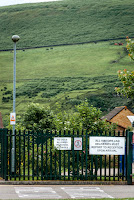Here is a picture of my Auntie Bet probably taken at the end
of the 1940s.
 |
| Penyrheol Station |
She is standing at Penyrheol station, which is on the line from
Senghenydd to Caerphilly known as the Aber branch.
Of course the line is no longer there. Passenger traffic was
stopped in 1964. The station at Penyrheol is no longer there. If you don't know
where to look, you just wouldn't know where the railway line was and where the
platform stood. The only clue is in the name of the road ‘Station Terrace’. As
you go towards B4263, it is on the right before you come to the roundabout. The
road rises but there is not even a railway bridge to let you know that trains
passed underneath. Here is a picture of the spot now - just a little bit
wasteland leading to some industrial units.
As you look towards Caerphilly you
can see the hint of straightness left by the impression of the tracks.
On the left to where the station stood is the entrance to
the Aber Valley Cycle Track which is the path for today’s journey. The track
runs next the sound of the small river and as always with these ex-railway
cycle tracks there are only a few reminders of what they were originally - the
gate of a small level crossing. a bridge over the line and occasionally piles
of limestone ballast.
After a mile or so, all uphill, is the remnants of Abertridwr station. I walk over the raised area of the platform and stand where
the ticket office probably was.
 |
| Abertridwr Station |
I find the entrance to the station and walk up a side street. An old lady is waiting for a
bus.
She smiles, “Are you taking photographs because your family
came from round here?”
“Sort of. Do you
remember the station?”
“Yes of course. It was the only way we could travel then. No
buses. Just scandalous that they closed it all.” She pauses. “Everything
changes.” She looks back toward the valley side. “I live in that terrace over
there. Out my back I could just look and see the mountain. But then they build
houses and I tell you they're the worst looking houses in the world. Townhouses
they call them. Ugly three-storey things. That's all I see out my back window
now houses. Lost my view I have. But all told, it's a nice village to live in.”
I tell her about the little flowery china vase I found
amongst my mother's possessions when she died. It had ‘A Present from
Abertridwr’ written on the side in gold paint, just like the ones you see from
Blackpool or Barry Island. “I know it's nice to give gifts but I can't imagine
why they made something as a present from Abertridwr.”
She laughs at me. “Well, we did that sort of thing then. And
I bet I know the shop that it was bought from. That shop sells kababby things
now.” Another pause. “Everything changes.”
The bus comes and she tells me she's only going one stop,
just to the square as it saves her legs and she has her bus pass.
I go back to the station and cycle just a few yards and go
over a road and take a photograph of the Working Men's Institute. John Roberts
known as ‘Jack Russia’, the Communist councillor and Spanish war veteran was
the manager here, obviously not being a desirable employee for the coal owners
after his activities.
 |
| Abertridwr Working Men's Institute |
From Abertridwr the cycle path seems to go in a variety of loops
round the area that was Windsor Colliery. The area now flattened. There are
some new houses and new school on part of the site.
I visit the memorial to those who died in the pit. It is a
black round column and if you look closely at the top you can make out a model presumably
of the pithead. To really see it you would have to be level perhaps on by standing
on a ladder. In comparison to the images of miners and the names of those who
died underground the model is small. The whole monument does imply that there was a
top but the activity and the deaths were all underneath.
 |
| Windsor Colliery Memorial |
As you leave the
cycle path the bridge that would have been over the railway has printings in commemoration
to the mining disasters of 1901 and 1915.
I cycle into Senghenydd Square, signified by the War
Memorial which as always in these cases was erected by the great and good of
the area long before the Memorial to those who died underground in pursuit of
coal.
 |
| Senghenydd Square |
In the cafe a man eating his jumbo breakfast says, “I see
that you locked your bike to the War Memorial. You have to be careful around here.”
I nod.
“Have you been to the mining Memorial yet?” he asks.
“Not today. Bacon sandwich and then home. Downhill now”
“Like everything else around here.”
We laugh together.





